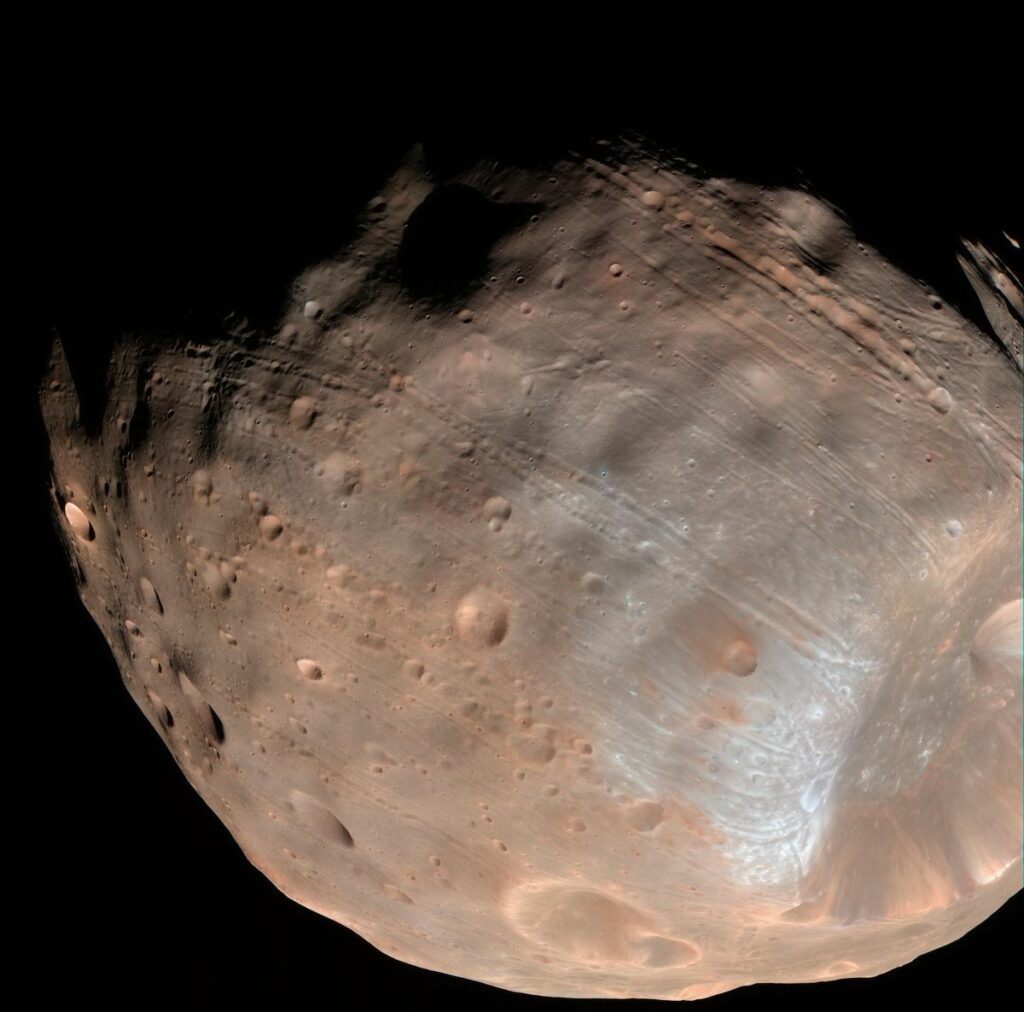A recent study proposes that Phobos, one of Mars’ moons, could actually be a comet that has become trapped.
There has been an indication based on a new study that looks at images that have not been made public before that Phobos which is the moon of the Mars could be a comet or even part of one that was captured by the planet through gravitation. Indeed, the source of an Earth-Mars Trojan asteroid pair that makes up Phobos and Deimos remains a mystery to researchers.
Cuts have suggested that the saturated moons were probably asteroids captured by the pull of Mars since they are rock similar to what is seen in the asteroid belt between Mars and Jupiter. However, and despite several attempts of modeling this capture process, these fail in reproducing the nearly circular orbits in Mars that characterize Phobos and Deimos.
A third theory postulates that both Phobos and Deimos originated as Mars’ moons but were ripped off by a giant impactor akin to what is believed to have formed Earth’s moon. The problem is that this theory is scarcely possible owing to the chemical inapplicability of Phobos and Mars. The Martian Moons eXploration (MMX) mission that is going to be launched by Japan Aerospace Exploration Agency (JAXA) has the potential to scientifically ascertain the nature of Phobos.
Due to be launched in 2026, this mission will go a long way in shedding the light on many Phobos enigmas. Sonia Fornasier is a professor of astronomy at Paris Cité University and the coordinator of the MMX mission study and an instrument scientist for the mission. When Fornasier and her colleagues were reviewing the images necessary to modify the future trajectory of the spacecraft, they found out accidentally more than 300 photos depicting the wonderful side of Phobos untouched by people before.
These images were obtained by powerful telescopic lenses installed in the Mars Express, a Mars orbiting spacecraft, belonging to the European Space Agency since 2003 which focuses on research on the red planet and its moons. Most of the images depict Stickney Crater which is the largest visible feature on Phobos and is about 9 kilometres (about 5. 6 miles) in diameter.
With these new images, Fornasier and her co-authors performed a study on the reflectance of sunlight on Phobos at different incidences. Using the method of photometry, they were able to determine the amount of light reflected from Phobos if the sun was before it or at various angles to it. This study gives general information concerning Phobos, especially concerning its possible composition.

The researchers were able to discover that the crater’s surface illumination was actually quite uneven on Phobos. Some parts where quite bright, for example the northern edge of the crater. However, the team’s analysis also showed that there were times where Phobos’s surface was ill-lit by the sunlight, but when the position of the sun was overhead, the surface seemed to be relatively brighter. An opposition surge is a pattern familiar to all bodies in the solar system that have no atmosphere. The researchers also found out that Phobos had a surface like sand because its porous nature. For this reason, the team assumed that there could be a thick layer of grooved dust that has no visible shadows when light is directly on the surface of the moon.
These two characteristics also hold true for Jupiter family comets which are comets that have had their orbits changed by the influence of Jupiter’s gravitational pull. Among them: the rubber ducky-shaped Comet 67P, about which much was revealed in 2016 by ESA’s Rosetta mission. In fact, the photometric characteristics of Phobos came out to be nearly the same as those of Comet 67P. Thus, the team came to the conclusion that Phobos might be a comet that Mars had taken on.
The conclusion of the study also has implications to Deimos. Fornasier noted that Deimos might have once been a comet just like Phobos was claimed to be. In fact, based on the study, her team speculates that the two moons might have once formed a bilobed comet which was captured and subsequently, ripped apart by the force of gravity in Mars. In other words, it can be said that Mars has twin moons that are in fact the two sides of the same moon.
“If the Martian satellites are indeed comets of the second type, then comets can be captured also by telluric planets,” Fornasier added. Kuiper said that the Kuiper Belt, which is the doughnut-shaped zone outside the solar system that is thought to be the birth place of many comets, is probably where some of the moons of gas giants such as Saturn could have formed. Phobos, however, may be the first ‘comet moon’ for terrestrial planets, as up to date, none of such have been identified.
However, this analysis has some issues associated with the comet hypothesis. Not all photometric characteristics match comets—the amount of scattered light, for example. Dynamical simulations that take into account positions of various bodies including the Martian moon Phobos and the planet of Mars allows the team to determine the feasibility of the comet capture, for instance as explained by Fornasier. Of course, the most promising path to demystifying the unknown origins of this peculiar moon is the MMX program, which will physically extract materials from Phobos directly.
The new study is forthcoming in the journal Astronomy and Astrophysics, and available on the preprint server arXiv.
Do not forget to share your opinion with us to provide you with the best posts !




0 Comments